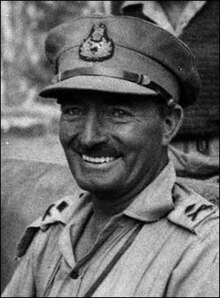George Erskine
Sir George Erskine | |
|---|---|
 | |
| Nickname(s) | "Bobby"[1] |
| Born | 23 August 1899 Hascombe, Surrey, England |
| Died | 29 August 1965 (aged 66) Rusper, West Sussex, England |
| Buried | Saint Mary Magdalene Churchyard, Rusper |
| Allegiance | United Kingdom |
| Service/ | British Army |
| Years of service | 1918–1958 |
| Rank | General |
| Service number | 15806 |
| Unit | King's Royal Rifle Corps |
| Commands held | Southern Command (1955–58) East Africa Command (1953–55) Eastern Command (1952–53) British Troops in Egypt (1949–52) British Forces in Hong Kong (1946–48) 43rd (Wessex) Infantry Division (1945–46) 7th Armoured Division (1943–44) 69th Infantry Brigade (1941–42) 2nd Battalion, King's Royal Rifle Corps (1940–41) |
| Battles/wars |
|
| Awards | Mentioned in Despatches |
| Relations | Major General George Elphinstone Erskine (father) |
Early life and First World War
Erskine was the son of Major General
Erskine was educated at
Second World War

In 1939 Erskine became a
During the Battle of Normandy in June and July 1944, the British Second Army commander, Lieutenant General Miles Dempsey, was unimpressed with the performance of the 7th Armoured Division and the VIII Corps commander, Lieutenant General Richard O'Connor, considered Erskine's direction of the division during Operation Goodwood excessively cautious.[6] Shortly afterwards, in the difficult bocage country during Operation Bluecoat, the 7th Armoured Division failed to gain its objectives and Erskine was sacked and replaced by Gerald Lloyd-Verney. In spite of his indifferent performance as a field commander, Erskine had qualities which suited him to other roles and this episode proved only a temporary setback to his career.[6] He became Head of the Supreme Headquarters Allied Expeditionary Force Mission to Belgium in 1944 and then GOC 43rd (Wessex) Infantry Division in 1945.[4]
Later career

After the war, Erskine was Commander of British Forces in Hong Kong in 1946, Director General of the Territorial Army 1948 to 1949 and GOC British Troops in Egypt in 1949. Returning to the United Kingdom, he became GOC-in-Chief, Eastern Command in 1952.[7] In 1953 he was appointed GOC-in-Chief, East Africa Command where he had command of all security forces, including the colonial police.[8] He was responsible for overseeing the response to the Mau Mau rebellion in Kenya, and led Operation Anvil in Nairobi in April 1954.[8]
Upon taking command, Erskine issued an order that read: "I will not tolerate breaches of discipline leading to unfair treatment of anybody," and ordered that "every officer... should stamp on at once any conduct which he would be ashamed to see used against his own people." This did not stop Erskine from concealing incidents such as the Chuka massacre, though he also took steps to prosecute Major G.S.L. Griffiths, the officer responsible for the latter incident.[9] Erskine was GOC-in-Chief, Southern Command from 1955 to 1958, when he retired.[4]
In a letter to the British government, not made public until 2005, Erskine described his direct knowledge of atrocities committed by the security forces during the suppression of the uprising, including instances of torture and murder: "There is no doubt that in the early days... there was a great deal of indiscriminate shooting by army and police. I am quite certain prisoners were beaten to extract information. It is a short step from beating to torture and I'm now sure... that torture was a feature of many police posts."[2] According to historian Fabian Klose, Erskine made extensive use of forced resettlement and mass internment to "break the back of the insurgency."[8]
Erskine was appointed
After retirement
Erskine was an
Family
Erskine married Ruby de la Rue, daughter of Sir Evelyn de la Rue, 2nd Baronet, in 1930. They had two sons and one daughter.[3]
References
- ^ Mead, p. 129.
- ^ a b Bowcott, Owen (5 February 2005). "Army tortured Mau Mau rebels in 1950s". The Guardian.
- ^ a b c d e General Sir George Watkin Eben James Erskine The Peerage
- ^ a b c d e f "Sir George Watkin Eben James Erskine]". Liddell Hart Centre for Military Archives. King's College London. Archived from the original on 17 October 2013.
- ^ "No. 35928". The London Gazette (Supplement). 23 February 1943.
- ^ a b Mead, p. 131.
- ^ "Army Commands" (PDF). Retrieved 8 June 2020.
- ^ ISBN 978-0-8122-0782-8.
- ^ Anderson, David; Bennett, Huw; Branch, Daniel (August 2006). "A Very British Massacre". History Today. 56 (8): 20–22.
References
- Anderson, David; Bennett, Huw; Branch, Daniel (August 2006). "A Very British Massacre". History Today. 56 (8): 20–22.
- Mead, Richard (2007). Churchill's Lions: a biographical guide to the key British generals of World War II. Stroud (UK): Spellmount. ISBN 978-1-86227-431-0.
- Smart, Nick (2005). Biographical Dictionary of British Generals of the Second World War. Barnesley: Pen & Sword. ISBN 1844150496.
